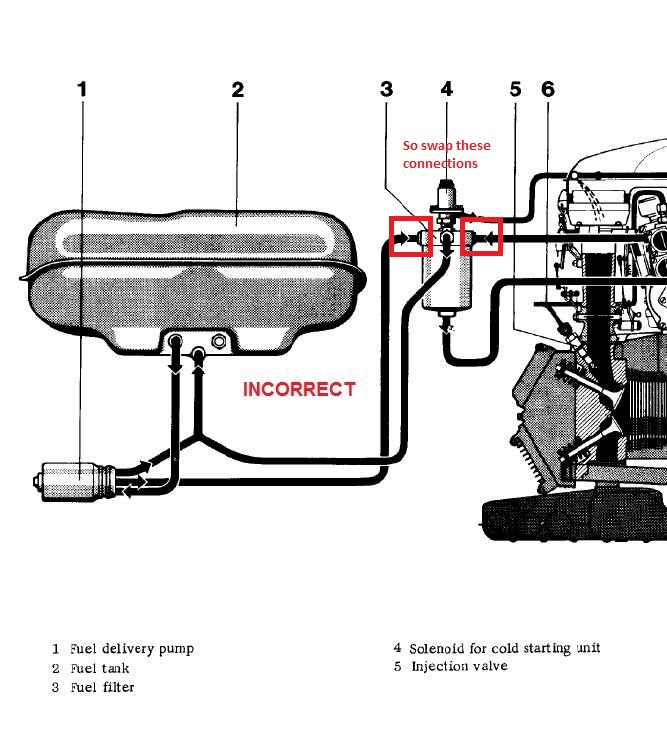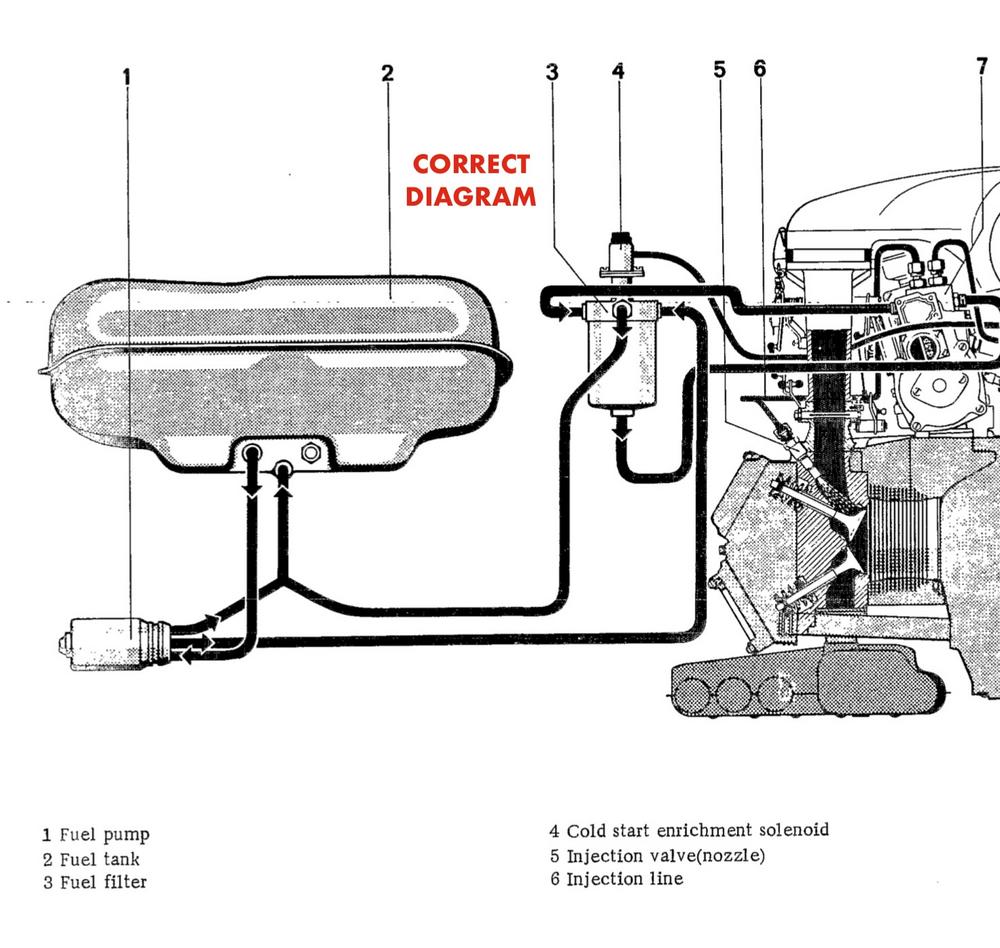180 degree shutdown 1972 911T jetronic
My 1972 911T starts and runs perfectly until the oil temperature reaches 180 degrees, then the fuel shuts off and the valves make a lean running noise and the engine stops. When the temperature reaches 160 degrees the engine starts and runs perfectly until the oil temperature reaches 180 degrees. Any suggestions on what might be causing this? Thank you
- aboyandhisdog
- Posts: 101
- Joined: Thu Nov 24, 2022 7:38 pm
- Has thanked: 74 times
- Been thanked: 32 times
Okay, I'll be "that guy" and ask the obvious...could it be a vapor lock kind of thing? I'm not familiar with the Jetronic, but I did have a '71 "E" with the mechanical injection. Is the fuel line routing the same as ever? Have you changed anything at all fuel related? Could your fuel pump be on its last leg? All your vacuum lines look good? Hopefully somebody with a lot more knowledge than I will chime in here...
Tom,
Thank you for the vapor lock tips. I have replaced the fuel filter; the fuel pump is relatively new, and the fuel lines are in the original configuration with a return line going back into the fuel tank. I will check all the vacuum lines. I will do another check, since your reminder about vapor locking. I will use an infrared digital laser thermometer to try and find a hot spot.
This car went through a professional nut and bolt full restoration by a reputable company in 2000. It has performed very well with no issues until this temperature problem two years ago. I purchased a PMO Pressure control unit from Pelican but have not installed it yet as the instructions call for removing the fuel filter and putting the PMO in its place. I'm not comfortable with removing the filter. thanks again, Carl
Thank you for the vapor lock tips. I have replaced the fuel filter; the fuel pump is relatively new, and the fuel lines are in the original configuration with a return line going back into the fuel tank. I will check all the vacuum lines. I will do another check, since your reminder about vapor locking. I will use an infrared digital laser thermometer to try and find a hot spot.
This car went through a professional nut and bolt full restoration by a reputable company in 2000. It has performed very well with no issues until this temperature problem two years ago. I purchased a PMO Pressure control unit from Pelican but have not installed it yet as the instructions call for removing the fuel filter and putting the PMO in its place. I'm not comfortable with removing the filter. thanks again, Carl
- blueline
- Moderator
- Posts: 3577
- Joined: Mon Sep 26, 2022 12:22 pm
- Location: Middle Tennessee
- Has thanked: 2330 times
- Been thanked: 1166 times
Amazing how the obscure can manifest itself in the oddest ways. Glad that you have already gotten some advice. Others here with ideas may chime in eventually too as that is definitely a perplexing issue.chbaxter1 wrote: ↑Sun Oct 08, 2023 7:09 pm My 1972 911T starts and runs perfectly until the oil temperature reaches 180 degrees, then the fuel shuts off and the valves make a lean running noise and the engine stops. When the temperature reaches 160 degrees the engine starts and runs perfectly until the oil temperature reaches 180 degrees. Any suggestions on what might be causing this? Thank you
Meanwhile, welcome to Carpokes Carl!
Tim
'24 Cayenne S - Algarve Blue Metallic
'22 992 Turbo S - Carmine Red
'21 718 Cayman GT4 - White
'21 718 Cayman GTS - black
'11 GMC 1500 Quad Cab 4x4 - black
Musik-Stadt Region
'24 Cayenne S - Algarve Blue Metallic
'22 992 Turbo S - Carmine Red
'21 718 Cayman GT4 - White
'21 718 Cayman GTS - black
'11 GMC 1500 Quad Cab 4x4 - black
Musik-Stadt Region
- Tom
- Site Admin
- Posts: 5301
- Joined: Fri Jun 25, 2021 2:04 pm
- Location: Silicon Valley, CA
- Has thanked: 499 times
- Been thanked: 2337 times
- Contact:
I assume this is a US Bosch MFI car (i.e., not a carbureted Euro car). The temp may not be the root cause. On old MFI cars with rusty gas tanks, one common problem is that the fuel tank screen will get clogged with rust flakes after running the motor for 10-15 minutes (about the time it takes to get up to temp). The fuel returning to the tank kicks up rust from the floor of the tank and then gets sucked up against/into the tank strainer, causing fuel starvation. After the car sits a bit (and temps go down) with no suction on the strainer, the rust settles back to the tank floor and the fuel pressure comes back. You can check that with a fuel pressure gauge, but on a '72 if you haven't changed the tank strainer and don't know its condition, it's worth changing whether or not the cause of your current issue. And if the tank is full of rust, replacing the tank with a brand new one may be your best move (although it can also be cleaned and coated inside). You can peek in there with a flashlight by removing the fuel level sender. Of course, it could be other things, but fuel pressure after driving a while is high on the list of things to check!
- Tom
- Site Admin
- Posts: 5301
- Joined: Fri Jun 25, 2021 2:04 pm
- Location: Silicon Valley, CA
- Has thanked: 499 times
- Been thanked: 2337 times
- Contact:
Nice to get some pro input -- thank you! Don't be a stranger.
- Arne2
- Posts: 226
- Joined: Sat Sep 17, 2022 5:47 pm
- Location: Western Oregon
- Has thanked: 8 times
- Been thanked: 117 times
In the US, a '72 T has MFI. When I was first trying to get mine running (bought as an interrupted project), I ran into a similar issue. It started and ran well cold, but the warmer it got, the worse it ran, until it would stall and die when fully warm. Then it would start and run again after it cooled off.
I struggled with this for several weeks, until I got a hint from Mark Jung at MFI Werks. He told me that some of the fuel line diagrams for the MFI cars were incorrect, and if you hooked the lines up as the incorrect diagram showed, fuel supply would go away when things got warm.
This may or may not be related to your issue, but it is worth checking.
There are 4 fuel hoses connected to the fuel filter console on the left side of the engine compartment. The 4 lines are a supply (from fuel pump), a return line to the tank, supply line to the metering pump (out the bottom), and a return from the metering pump to the console.
My problem was that the supply line from the fuel pump and the return line from the metering pump were swapped. On the filter console housing, these two are both marked with an "IN" arrow. Swapping those to lines to their proper ports immediately fixed my issue.
The two ports to look at are the one pointing to the front of the car (which should be the fuel pump supply) and the one pointing straight to the rear (the return from the metering pump).
Here are the two (annotated) diagrams:


I struggled with this for several weeks, until I got a hint from Mark Jung at MFI Werks. He told me that some of the fuel line diagrams for the MFI cars were incorrect, and if you hooked the lines up as the incorrect diagram showed, fuel supply would go away when things got warm.
This may or may not be related to your issue, but it is worth checking.
There are 4 fuel hoses connected to the fuel filter console on the left side of the engine compartment. The 4 lines are a supply (from fuel pump), a return line to the tank, supply line to the metering pump (out the bottom), and a return from the metering pump to the console.
My problem was that the supply line from the fuel pump and the return line from the metering pump were swapped. On the filter console housing, these two are both marked with an "IN" arrow. Swapping those to lines to their proper ports immediately fixed my issue.
The two ports to look at are the one pointing to the front of the car (which should be the fuel pump supply) and the one pointing straight to the rear (the return from the metering pump).
Here are the two (annotated) diagrams:
- Arne
Current - 2018 Cayman 2.0 litre
Past - 1984 911 Carrera, 1984 944, 1973 914 2.0, 1972 911T
Current - 2018 Cayman 2.0 litre
Past - 1984 911 Carrera, 1984 944, 1973 914 2.0, 1972 911T
- aboyandhisdog
- Posts: 101
- Joined: Thu Nov 24, 2022 7:38 pm
- Has thanked: 74 times
- Been thanked: 32 times
This is all outstanding information...very impressive! He did mention, however, that the car has run great since 2000 until just two years ago when the cut-out issue began. It would be interesting to learn if any fuel related parts were replaced or worked on at that time. This could again point to the clogged strainer as that condition could just happen out of the blue over time.
This information is very much appreciated and will be applied to as quickly as possible.
When this problem began, I removed the screen filter at the bottom of the tank and flushed it with solvent. very few fine particles flushed out and the screen is clear when light is shown thru it. The tank was coated on the inside with Hirsch Sealer in 2000 and still looked good two years ago. At that time, I also replaced the fuel filter and dissected the old filter just to see what was going on. The old filter element was clean.
The injectors are Bosch MFI.
I can't wait to check out ARNE2's diagrams and let all know what I find. Thanks again Carl
When this problem began, I removed the screen filter at the bottom of the tank and flushed it with solvent. very few fine particles flushed out and the screen is clear when light is shown thru it. The tank was coated on the inside with Hirsch Sealer in 2000 and still looked good two years ago. At that time, I also replaced the fuel filter and dissected the old filter just to see what was going on. The old filter element was clean.
The injectors are Bosch MFI.
I can't wait to check out ARNE2's diagrams and let all know what I find. Thanks again Carl


